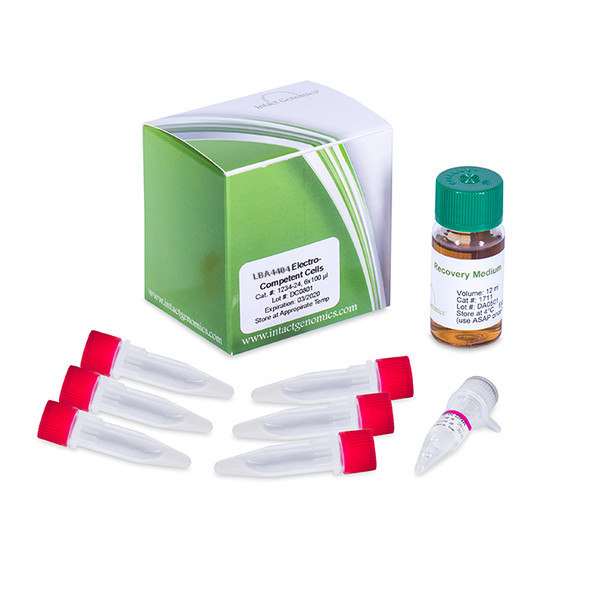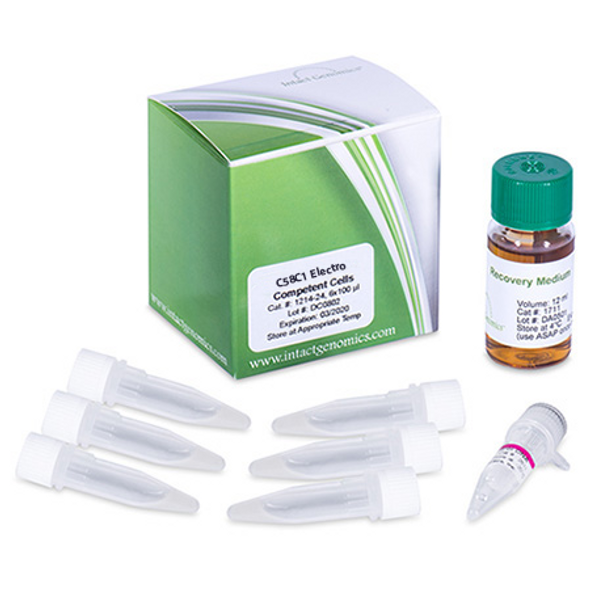Description
Intact Genomics Agrobacterium tumefaciens AGL1 (AGL-1) cells electroporation with a binary vector allows for subsequent Agrobacterium-mediated transformation of Arabidopsis thaliana as well as maize and other monocots.
Description
Intact Genomics Agrobacterium tumefaciens AGL1 (AGL-1) cells are optimized for the highest transformation efficiencies which is ideal for applications requiring high transformation efficiencies, such as with cDNA or gDNA library construction.
The AGL1 strain has a C58 chromosomal background that carries an insertion mutation in its recA recombination gene which stabilizes recombinant plasmids. It also carries rifampicin and carbenicilin resistance in its genome for selection. AGL1 contains the Ti plasmid pTiBO542 from which the T-DNA region sequences have been deleted. Transformation with a binary vector containing the missing T-region results in a functional T-DNA binary system that allows for transfer of genetic material into a host plant’s genome. Therefore, this system is often used for Agrobacterium-mediated transformation of Arabidopsis thaliana as well as maize and other monocots.
Specifications
Competent cell type: Electrocompetent
Species: A. tumefaciens
Strain: AGL1
Format: Tubes
Transformation efficiency: ≥ 1 x 107 cfu/µg pCAMBIA1391z DNA
Blue/white screening: No
Shipping condition: Dry ice
Reagents Needed for One Reaction
AGL1 ElectroComp Agrobacterium: 25 µl
DNA (pCAMBIA1391z, 500 pg/µl): 1 µl
Recovery medium: 1 ml
Storage
AGL1 ElectroComp Agrobacterium: -80 ºC
pCAMBIA1391z control DNA: -20 ºC
Recovery medium: 4 ºC
Quality Control
Transformation efficiency is tested by using the pCAMBIA1391z control DNA supplied with the kit and using the protocol in this manual. Transformation efficiency should be ≥1 x 107 CFU/µg pCAMBIA1391z DNA. Untransformed cells are tested for appropriate antibiotic sensitivity.
General Guidelines
Follow these guidelines when using AGL1 ElectroComp Agrobacterium:
- Handle competent cells gently as they are highly sensitive to changes in temperature or mechanical lysis caused by pipetting.
- Thaw competent cells on ice, and transform cells immediately following thawing. After adding DNA, mix by tapping the tube gently. Do not mix cells by pipetting or vortexing.
Note: A high-voltage electroporation apparatus such as Bio-Rad Gene Pulser II #165-2105, capable of generating field strengths of 16 kV/cm is required.
Calculation of Transformation Efficiency
Transformation Efficiency (TE) is defined as the number of colony forming units (cfu) produced by transforming 1µg of plasmid into a given volume of competent cells.
TE = Colonies/µg/Plated
Transform 1 µl of (500 pg/µl) pCAMBIA1391z control plasmid into 25 µl of cells, add 974 µl of Recovery Medium. Recover for 3 hours and plate 100 µl. Count the colonies on the plate in two days. If you count 500 colonies, the TE is calculated as follows:
Colonies = 500
µg of DNA = 0.0005
Dilution = 100/1000 = 0.1
TE = 500/.0005/.1 = 1×1071293-24 1293-48
1 Review
-
AGL1 ElectroCompetent Agrobacterium
Jestem bardzo pozytywnie zaskoczona. Zamówiony produkt dostałam dwa dni po momencie zamówienia. Produkt jest również bardzo łatwy w obsłudze.






